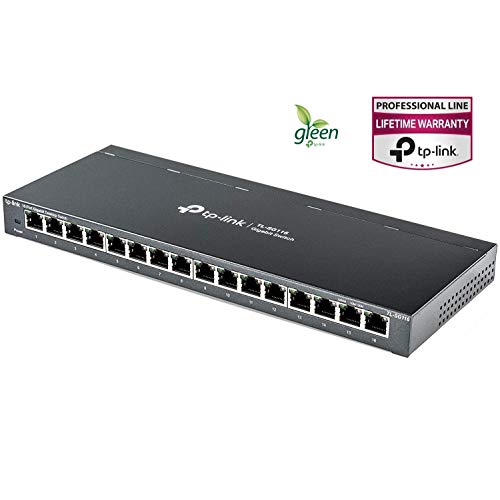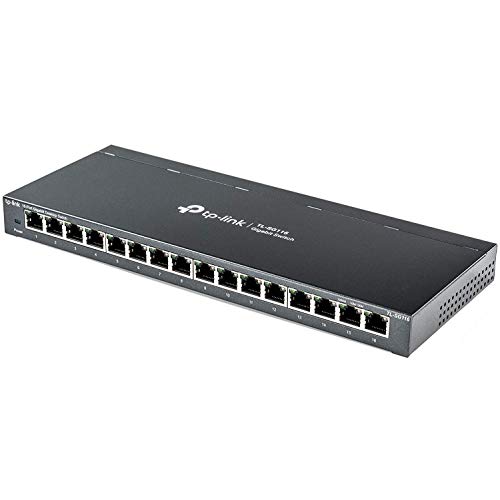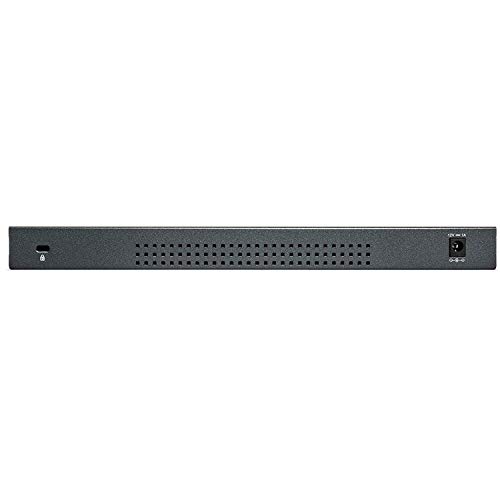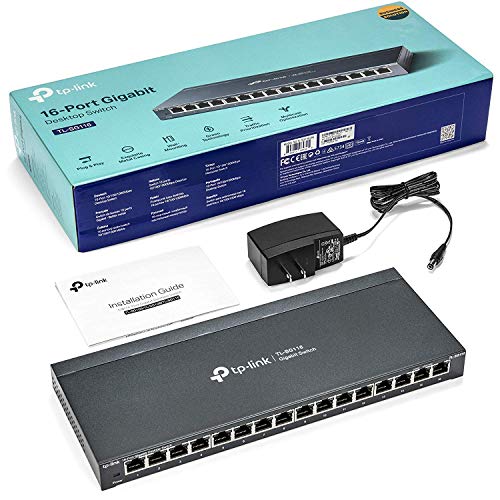- 16 10/100/1000Mbps Auto-Negotiation RJ45 ports supporting Auto-MDI/MDIX
- Green Ethernet Technology saves power consumption
- Ieee 802. 3x flow control provides reliable data transfer
- Steel housing, desktop or wall-mounting design
- Support 802. 1P/DSCP qos and IGMP snooping function
-
Information
-
Twitter
-
Pinterest
-
Youtube
-
Facebook






Neb Saitiam
Smokin'. Killer value.
Man - gigabit is the bomb. Tested my previous netgear switch with cat 5 against this gigabit switch with amazon basics cat 6 cables. A 20+ seconds file transfer (cat 5) was done in 2.7 seconds (gigabit and cat 6). I'm not used to the latest-greatest performing like manufacturer claims - but man, that's an impressive speed bump for under 20 bucks! All my previous swicthes from this manufacturer have run forever, too. It's a no brainer for transfering files around the house or office.
Kamal Kumar Rajak
Great to add Additional Ethernet Ports for College Dorm Room - Plug-and-Play
TP-Link's 5-Port Gigabit Ethernet Switch is great for those situations where you have limited ethernet ports. As advertised, the unit is truly plug-and-play; plug the power cable into a wall outlet, connect an ethernet cable from the wall (LAN) to the switch, connect your other ethernet devices to the switch. My son's dorm room only has TWO ethernet ports (which were placed behind the desk); this ethernet hub allows him and his roommate to utilize the college's extremely fast ethernet network for their computers and smart TV versus the crowded and slow WIFI network. HUGE DIFFERENCE IN SPEED OVER WIFI
Reina DE Sur
Got an 8 and 5 port for Gigapower
I got an 8 port for behind my TV and a 5 port for my office and couldn't be happier. I got AT&T fiber and was only getting like 100 mbps over wifi which wasn't going to fly. I got an ethernet cable and wired up my PCs in the office and my xbox, ps4, smart tv, cable box, cloud drive, etc behind the tv and everything is getting close to the speed I am paying for. The PCS both get in the 900s and the xbox is getting around 800 mbps through these switches. I was going to get the more expensive ones but these ones work great! Why pay more.
Crystal Love
Extension of your router, not your modem!
Make sure you understand (unlike me) that this is an extension of your router, and an indirect extension of your modem! Plug this box into the out on your router, THEN plug all your other devices into this box. Basically. . .. . Modem to Router, Router to this box and finally all other devices off this box. I may be a bit repetitive here, but I just want no one else to waste a hour of their time trying to figure out that concept. I was thinking that if I plugged the modem into this and then everything else into it, it would work. It didn't. Sometimes I feel like Bill Gates, other times I feel like a complete moron. I'm giving this five stars because I just got it to work and haven't had enough time to see it do anything wrong.
Kara McKinney
The TP-Link came into play like this.
After hardwiring our house in one room there was a laptop, desktop, Xbox and Playstation. We only had one RJ45 cable from the hardware run and was switching it from one device to the other. The TP-Link came into play like this..... Port 1 we plugged the RJ45 cable we had (input). Port 2 laptop. Port 3 desktop. Port 4 Xbox. Port 5 Playstation. There is no configuration, no rebooting or powering off anything. We just plugged in the TP-Link and made our connections per described above. It works like a cable TV splitter. You will need small RJ45 cables to connect each port to your additional devices. In my case I purchased four CAT5E (CAT6 and CAT 7 cables will work too) for devices mentioned above.
Jamil Hassan
IT guy's perspective
Working in the IT field for over 14 years now, this is a great little switch! It offers layer 2 switching functions including VLAN and QoS. The hardware itself was built really well and has that "business grade" metal feel to it. It comes with 4 rubber feet to attach for desktop use but they are left unattached in case you wanted to wall mount it. IMPORTANT: This product has a version 1 and a version 2. The major difference (and possibly the only difference) is that V1 in only configurable via a software utility you have to install from disc, whereas, V2 is configurable via a web GUI which for me was a MAJOR plus. I received the V2 product thankfully. I didn't do anything special when ordering, I'm guessing the supplier flushed out all the V1s. From un-boxing to walking away, it took me all of 15 min. And that's only because I geeked out on looking through all the cool settings. You could be up in running in less than 10 if you're used to this kind of equipment. My initial experience with this unit has been fantastic. I would recommend this to anyone no problem.
Sky Moe Sky Moe Ei
Solid buy. Recommended, but see details
Use Case I crawled around and put about 6000ft of Cat5E witing into my old house, but there was one attic that I only ran two lines to. As a temporary measure I put an 8 port switch up there and used a bunch of individual PoE injectors. The purchase of the TL-SG1016PE is meant to replace all of that, and act as a more permanent solution. Build Quality The TL-SG1016PE is standard fare when it comes to SOHO networking products. It's in a metal housing that seems durable enough. The unit it 1U in height, and includes flanges to mount into a 19" rack. The case has hexagonal perforations for ventilation, along with 40mm fans. Thankfully, the power supply is internal, and the power hookup is a standard C13 jack. A straight C13 cable is included. Setup/Performance I bought a cheap 4U 19" bracket to mount to a stud in the attic, but it's one of the shallow wiring type brackets for punchdowns. The TL-SG1016PE's mounting brackets support the switch being mounted vertically (where the flanges are rotated 90 degrees). I mounted the switch in the lowest U position, and a punchdown block will go in the top position. The fit is good, and there were no surprises. I think this is a really good mounting option for newer homes that have structured wiring coming back to a closet (usually a master bedroom closet), as it can significantly reduce the practical space/footprint consumed. The PoE ports of the device work fine, but it's worth noting that the total power budget of the device is 110W. While I will not end up using anywhere near this, it's still good for you to know that the limitation exists. This switch supports 802.3at-2009, which can max out the power budget at 4 devices (even though there are 8 ports). For reference, the 5 cameras that I have on the switch consume about 24W total (and that's at night when the IR consumes more power). When I have the full complement of 8 cameras on the device, I still won't be anywhere near the power budget. There isn't much to the setup of the hardware portion of the switch, but that still leaves the configuration of the "smart" management of the switch. While the TL-SG1016PE is not a full L2/L3 managed switch, it does have some limited extra functions. In order to access the switch, you can use a TP-Link software application to set the IP address of the switch - it's included on CD, but you can use the one you have installed already if you have any other TP-Link switched already. I prefer to assign static addresses, but DHCP is available, too. Once you've assigned the IP, you can access the web management interface. While I was able to log in with Microsoft Edge, I wasn't able to change the device password unless I used Chrome; Edge seemed to work for all other functions. The first thing I did was change the device password. I then created a link aggregation group (LAG) for the two lines that I'd run to the attic, which creates a higher bandwidth connection back to a switch (or computer) on the other end, provided that the other end supports it as well. The last thing I did was to create a VLAN for the cameras, which I think is a smart idea for anyone that has externally mounted cameras. Some of my cameras are mounted high up on the house, but others are low enough that someone could access the ethernet cabling with a stepladder... if they do, the VLAN limits the LAN access that the person would have. The web management includes PoE configuration and usage details. You can set a switch-wide power limit, as well as per-port power policy. I just left everything at auto. The usage details are comprehensive, displaying exactly what the negotiated power level was, along with the instantaneous usage. Something worth noting is that the TL-SG1016PE, like the switch I was using before it, will be operating in environmental conditions that are out of spec for the unit. The switch has an operating temperature limit of 40C, and the attic routinely gets hotter than that. The robust cooling of the unit, along with the relatively low power draw I will have (compared to the 110W max), should give me at least a few good years of operation. I'd consider that to be a great result. Conclusion There are a few things I would change about the TL-SG1016PE: 1. It would be nice if the unit shipped with the current firmware (it doesn't). There are a couple notable differences between the 5/18 firmware and the 5/17 firmware that ships on the device. I recommend loading the new one ASAP 2. I would prefer foam filters on the vents. This is not something that most people wouldn't want or need, but I've got my unit in an attic... 3. It would be nice if the unit (which uses temp-controlled fans, I think) would have hall-effect RPM monitoring of the 40mm fans, and could notify the admin of fan failure 4. It would be nice if there was some syslog or SNMP support Ok, so that's out of the way... none of the items above are absolutely necessary. As it is, the TL-SG1016PE is performing flawlessly. The VLAN and LAG are functioning correctly, and the PoE hasn't had any faults with my cameras. I highly recommend this item.
Jessica Blakeney
This was a perfect fit.
UPDATE: May 21, 2019 This router still works like a charm. I have never needed to restart it or even touch it. I highly recommend. ORIGINAL REVIEW: March 1, 2016 I have the 5 port 'unmanaged' version and it's working perfectly. I'm using this with a TP-Link OnHub. It's small size is allowing me to finally hide the wired portions of my home network inside a cabinet in my living room. There's no setup necessary. Plug it to the wall for power and plug a Ethernet cable between the wireless router and this and that is it. All my devices that promised Gigabit access are running at gigabit speed (at least according to the lights on the Switch.) The one device that doesn't have Gigabit is showing in yellow. The XBox and networked hard drive aren't complaining. It generates a little bit of heat, but no where near as much as a cable modem. Currently I'm using double sided tape to stick it on the inside wall of a cabinet. Google's OnHub routers are designed to be out in the open without looking like a mutant robotic porcupine with a tangle of tentacles trailing behind it. OnHub only has one Ethernet with the idea that you'll either be all wireless, or you will utilize a Switch and conceal the rest of the network. This Switch is allowing me to do just that. So far I'm pleased with it. :)
Yandy Toussaint
Plug-n-play. Solid performance, solid feel
For typical home use, this 5 port GB switch is great. I’ve been using theirs brand for 10 years and two of this particular 5-port GB switch model for 6 months. I prefer to use hardwired connections for all my non-portable network devices. That means that low-demand devices are connected as well has high-demand devices. It also means that each switch will have at most one connected device needing defined quality of service. This switch is perfect for that environment. A bit more: an unmanaged device like this is great to expand each drop of a managed switch/router. For example, have two computers, and a printer in one bedroom that has one Ethernet drop. This 5-port switch lets me connect the three devices, with growth for a fourth. In the living room, the one of these switches allows connection of a TV, an Apple TV, an internet radio-capable receiver, and a blu-ray player. The blu-ray player connection is for firmware updates. For source material over the internet, I use only one of the devices at a time, so there’s no competition for throughput or quality of service. The lack of managed network control in this switch has no observable negative effect on my family’s network-related activities. That this switch is unmanaged is not a practical concern for my uses and, I expect, most other home uses. In a small office environment, the throughput of the rest of the network and each computer is likely to be more of a limiting performance factor than this switch. So, if your needs are for a few devices connected to one Ethernet drop, strongly consider choosing this switch.
Goldy Sharma
Nice Rack Mountable Switch - Does Include the Necessary Rack-Mount Hardware!
This is a basic unmanaged 16 port gigabit switch with all the basic features needed for someone running a small home network (or possibly a small office network). The switch is fanless and thus 100% quiet, and all of the ports automatically detect what is plugged into them and will adjust accordingly. This means that not only do they auto-negotiate with devices operating at other speeds, but they also will detect which port is coming from your router (or another switch) without you having to use a specific port for that purpose. There seems to be some confusion between this model (TL-SG1016) which is designed as a rackmount switch and the other version (TL-SG1016D) which can either be a rackmount OR a desktop switch. Functionality wise there is no difference between the two, however the "D" version is only 13 inches wide and if you wish to rack mount it, you'll use the included brackets which allow it to mount to a 19 inch rack. The non "D" version (the version I purchased) is 19" and does come with the rack mount ears that allow you to fasten it to the rack itself. There is some misinformation out there that suggests this version doesn't come with the rack mount hardware and that is simply incorrect. It doesn't come with the rackmount "kit" that the "D" version includes because it isn't necessary as it is already the correct width, but it does come with the rackmount ears and the screws required to fasten the ears on to the switch. It does NOT come with screws used to fasten the switch to the actual rack, but that is likely because there are several different sizes of rack screws... so you're on you own there. One interesting thing about the mounting ears is that they are designed to be rotated in four directions. This means you can mount the switch directly to a wall simply by rotating the mounting ears 90 degrees. You can also rotate them 180 degrees to allow the switch to sit in front of the face of your rack as this pushes the mounting position back around two inches. If you have a shallow mounting bracket rather than a full rack this may be useful, but keep in mind the power cord for this unit goes directly out the back, so depending upon how much space you have it could still pose problems. Each ear mounts with four screws (also included) and they are plenty sturdy. They also include some rubber feet if you decide to sit this on a shelf. Not much else to it. If you want a rackmount option this is a good one. If you prefer something a bit smaller that you could leave on a desk or on shelf near your cable modem, you might find the "D" version is a better fit. The only real difference is physical size and how much air space is inside the case.